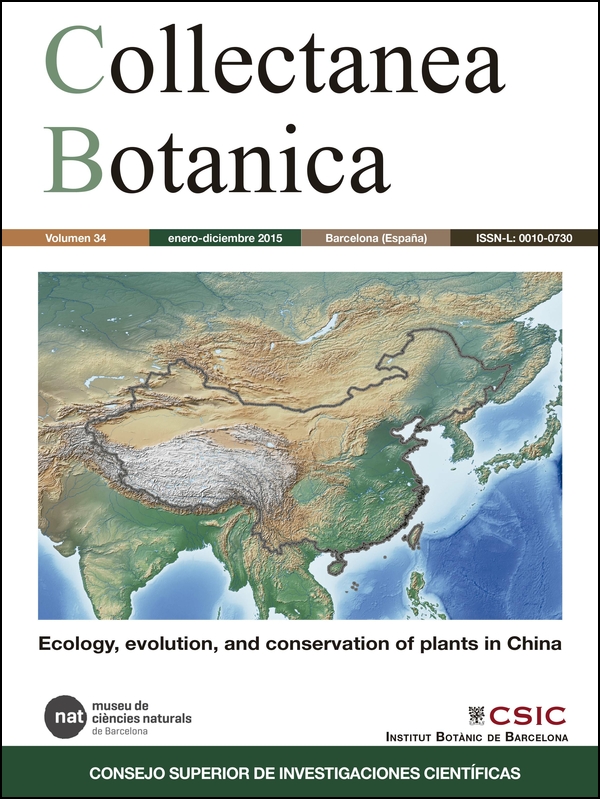Urban green spaces and plant diversity at different spatial–temporal scales: A case study from Beijing, China
DOI:
https://doi.org/10.3989/collectbot.2015.v34.008Keywords:
Beijing, China, green spaces, invasive species, land use, socio-economics, urban ecologyAbstract
Beijing, the capital city of China, is one of the largest and most rapidly-urbanizing cities in the world. In this work, we present the main results of one decade’s research on urban vegetation and plant diversity changes in different urban structural units. Urban vegetation/plant diversity has been studied at two different levels: at the landscape level (greening percentage, fragmentation degree) and at the plant species level (structure, composition, and origin). Finally, concerns with the ability to study Beijing’s plant urban ecology are discussed.
Downloads
References
BMBS (Beijing Municipal Bureau of Statistics) 2012. 2012 [Statistical yearbook of Beijing 2012]. China Statistics Press, Beijing [in Chinese].
Cadotte, M. W., Cardinale, B. J. & Oakley, T. H. 2008. Evolutionary history and the effect of biodiversity on plant productivity. Proceedings of the National Academy of Sciences of the United States of America 105: 17012–17017. http://dx.doi.org/10.1073/pnas.0805962105 PMid:18971334 PMCid:PMC2579369
Fink, J., Steiner, F., Grimm, N. B. & Redman, C. L. 2003. Greater Phoenix 2100: building a national urban environmental research agenda. In: Heiken, G., Fakundiny, R. & Sutter, J. (Eds.), Earth science in the city: A reader. American Geophysical Union, Washington, DC: 413–426. http://dx.doi.org/10.1029/sp056p0413
Gill, S. E., Handley, J. F., Ennos, A. R., Pauleit, S., Theuray, N. & Lindley, S. J. 2008. Characterising the urban environment of UK cities and towns: A template for landscape planning. Landscape and Urban Planning 87: 210–222. http://dx.doi.org/10.1016/j.landurbplan.2008.06.008
Grove, J. M., Cadenasso, M. L., Burch Jr., W. R. et al. 2006. Data and methods comparing social structure and vegetation structure of urban neighborhoods in Baltimore, Maryland. Society and Natural Resources 19: 117–136. http://dx.doi.org/10.1080/08941920500394501
Haw, S. G. 2007. Beijing – a concise history. Routledge, Oxon. Jiang, H., Fan, Q., Li, J.-T., Shi, S., Li, S.-P., Liao, W.-B. & Shu, W.-S. 2011 Naturalization of alien plants in China. Biodiversity and Conservation 20: 1545–1556.
Liu, Q. R., Yu, M. & Zhou Y. 2002. [A preliminary study on the invasive plants in Beijing]. Journal of Beijing Normal University (Natural Science) 38: 399–404 [in Chinese].
McPherson, E. G., Nowak, D., Heisler, G., Grimmond S., Souch C., Grant, R. & Rowntree, R. 1997. Quantifying urban forest structure, function, and value: the Chicago Urban Forest Climate Project. Urban Ecosystems 1: 49–61. http://dx.doi.org/10.1023/A:1014350822458
Peckham, S. C., Duinker, P. N. & Ordóñez, C. 2013. Urban forest values in Canada: Views of citizens in Calgary and Halifax. Urban Forestry & Urban Greening 12: 154–162. http://dx.doi.org/10.1016/j.ufug.2013.01.001
Profous, G. V. 1992. Trees and urban forestry in Beijing, China. Journal of Arboriculture 18: 145–154.
Tyrväinen, L., Pauleit, S., Seeland, K. & Vries, S. de 2005. Benefits and uses of urban forests and trees. In: Konijnendijk, C., Nilsson, K., Randrup, T. & Schipperijn, J. (Eds.), Urban forests and trees – A reference book. Springer, Berlin & Heidelberg: 81–114. http://dx.doi.org/10.1007/3-540-27684-X_5
UNEP (United Nations Environment Programme) 2009. Independent environmental assessment Beijing 2008 Olympic Games. UNEP, Nairobi.
Wang, H.-F., López Pujol, J., Meyerson, L. A., Qiu, J.-X., Wang, X.-K. & Ouyang, Z.-Y. 2011. Biological invasions in rapidly urbanizing areas: a case study of Beijing, China. Biodiversity and Conservation 20: 2483–2509. http://dx.doi.org/10.1007/s10531-011-9999-x
Wang, H.-F., MacGregor-Fors, I. & López-Pujol, J. 2012. Warm-temperate, immense, and sprawling: Plant diversity drivers in urban Beijing, China. Plant Ecology 213: 967–992. http://dx.doi.org/10.1007/s11258-012-0058-9
Wang, H.-F., Qiu, J.-X., Breuste, J., Ross Friedman, C., Zhou, W.-Q. & Wang, X.-K. 2013. Variations of urban greenness across urban structural units in Beijing, China. Urban Forestry & Urban Greening 12: 554–561. http://dx.doi.org/10.1016/j.ufug.2013.05.004
Weber, E., Sun, S. G. & Li, B. 2008. Invasive alien plants in China: diversity and ecological insights. Biological Invasions 10: 1411–1429. http://dx.doi.org/10.1007/s10530-008-9216-3
WHO (World Health Organization) 2014. WHO's Ambient Air Pollution database – Update 2014. WHO, Geneva. Retrieved November 7, 2014, from http://www.who.int/phe/health_topics/outdoorair/databases/AAP_database_results_2014.pdf?ua=1
Wong, E. 2014. 'Airpocalypse' smog hits Beijing at dangerous levels. The New York Times, January 16, 2014. Retrieved November 7, 2014, from http://sinosphere.blogs.nytimes.com/2014/01/16/airpocalypse-smog-hits-beijing-at-dangerous-levels/?_php=true&_type=blogs&_php=true&_type=blogs&_r=1
World Bank 2014. Urban China: Toward efficient, inclusive, and sustainable urbanization. World Bank, Washington, DC.
Wu, S.-H., Sun, H.-T., Teng, Y.-C., Rejmánek, M., Chaw, S.-M., Yang, T.-Y. A. & Hsieh, C.-F. 2010. Patterns of plant invasions in China: taxonomic, biogeographic, climatic approaches and anthropogenic effects. Biological Invasions 12: 2179–2206. http://dx.doi.org/10.1007/s10530-009-9620-3
Wu, W. & Zheng, X. 2014. Beijing considers 'air corridors' to reduce pollution. China Daily, August 4, 2014. Retrieved November 14, 2011, from http://www.chinadaily.com.cn/china/2014-08/04/content_18240394.htm
Xu, H., Qiang, S. & Genovesi, P. et al. 2012. An inventory of invasive alien species in China. NeoBiota 15: 1–26. http://dx.doi.org/10.3897/neobiota.15.3575
Zhang, J. 2013. Greening Beijing's rooftops. China Daily, October 22, 2013. Retrieved November 14, 2011, from http://www.chinadaily.com.cn/opinion/2013-10/22/content_17049480.htm
Published
How to Cite
Issue
Section
License
Copyright (c) 2015 Consejo Superior de Investigaciones Científicas (CSIC)

This work is licensed under a Creative Commons Attribution 4.0 International License.
© CSIC. Manuscripts published in both the print and online versions of this journal are the property of the Consejo Superior de Investigaciones Científicas, and quoting this source is a requirement for any partial or full reproduction.
All contents of this electronic edition, except where otherwise noted, are distributed under a Creative Commons Attribution 4.0 International (CC BY 4.0) licence. You may read the basic information and the legal text of the licence. The indication of the CC BY 4.0 licence must be expressly stated in this way when necessary.
Self-archiving in repositories, personal webpages or similar, of any version other than the final version of the work produced by the publisher, is not allowed.














